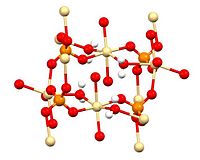Cadmium sulfate
 |
|
| Names | |
|---|---|
|
IUPAC name
Cadmium(II) sulfate
|
|
| Other names
Sulfuric acid, cadmium salt (1:1),
Niedermayrite |
|
| Identifiers | |
|
10124-36-4 7709-84-3 (monohydrate) 15244-35-9 (octahydrate) |
|
| 3D model (Jmol) | Interactive image |
| ChEBI |
CHEBI:50292 |
| ChemSpider |
23335 |
| ECHA InfoCard | 100.030.288 |
| EC Number | 233-331-6 |
| RTECS number | EV2700000 |
| UNII |
947UNF3Z6O |
| UN number | 2570 |
|
|
|
|
| Properties | |
| CdSO4 CdSO4·H2O (monohydrate) 3CdSO4·8H2O (octahydrate) |
|
| Molar mass | 208.47 g/mol (anhydrous) 226.490 g/mol (monohydrate) 769.546 g/mol (octahydrate) |
| Appearance | White hygroscopic solid |
| Odor | odorless |
| Density | 4.691 g/cm3 (anhydrous) 3.79 g/cm3 (monohydrate) 3.08 g/cm3 (octahydrate) |
| Melting point | 1,000 °C (1,830 °F; 1,270 K) (anhydrous) 105 °C (monohydrate) 40 °C (octahydrate) |
| Boiling point | (decomposes to basic sulfate and then oxide) |
|
anhydrous: 75 g/100 mL (0 °C) 76.4 g/100 mL (25 °C) 58.4 g/100 mL (99 °C) monohydrate: 76.7 g/100 mL (25 °C) octahydrate: very soluble |
|
| Solubility | slightly soluble in methanol, ethyl acetate insoluble in ethanol |
| -59.2·10−6 cm3/mol | |
|
Refractive index (nD)
|
1.565 |
| Structure | |
| orthorhombic (anhydrous) monoclinic (hepta & octahydrate) |
|
| Thermochemistry | |
|
Std molar
entropy (S |
123 J·mol−1·K−1 |
|
Std enthalpy of
formation (ΔfH |
−935 kJ·mol−1 |
| Hazards | |
| Safety data sheet | [1] |
|
EU classification (DSD)
|
Carc. Cat. 2 Muta. Cat. 2 Repr. Cat. 2 Very toxic (T+) Dangerous for the environment (N) |
| R-phrases | R45, R46, R60, R61, R25, R26, R48/23/25, R50/53 |
| S-phrases | S53, S45, S60, S61 |
| NFPA 704 | |
| Lethal dose or concentration (LD, LC): | |
|
LD50 (median dose)
|
280 mg/kg (oral, rat) |
| US health exposure limits (NIOSH): | |
|
PEL (Permissible)
|
[1910.1027] TWA 0.005 mg/m3 (as Cd) |
|
REL (Recommended)
|
Ca |
|
IDLH (Immediate danger)
|
Ca [9 mg/m3 (as Cd)] |
| Related compounds | |
|
Other anions
|
Cadmium acetate, Cadmium chloride, Cadmium nitrate |
|
Other cations
|
Zinc sulfate, Calcium sulfate, Magnesium sulfate |
|
Except where otherwise noted, data are given for materials in their standard state (at 25 °C [77 °F], 100 kPa).
|
|
|
|
|
| Infobox references | |
Cadmium sulfate is the name of a series of related inorganic compounds with the formula CdSO4·xH2O. The most common form is the monohydrate CdSO4·H2O, but two other forms are known CdSO4·8/3H2O and the anhydrous salt (CdSO4). All salts are colourless and highly soluble in water.
X-ray crystallography shows that CdSO4·H2O is a typical coordination polymer. Each Cd2+ center has octahedral coordination geometry, being surrounded by four oxygen centers provided by four sulfate ligands and two oxygen centers from the bridging water ligands.
Cadmium sulfate octohydrate can be prepared by the reaction of cadmium metal or its oxide or hydroxide with dilute sulfuric acid:
The anhydrous material is prepared using sodium persulfate:
Cadmium sulfate occurs as the very rare mineral drobecite (CdSO4·4H2O).
Cadmium sulfate is used widely for the electroplating of cadmium in electronic circuits. It is also a precursor to cadmium-based pigment such as cadmium sulfide. It is also used for electrolyte in a Weston standard cell as well as a pigment in fluorescent screens.
...
Wikipedia

